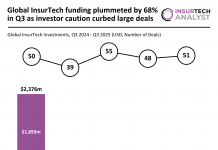While several vital technologies drive InsurTech growth, the rise of AI and chatbots has revolutionised the industry, says e-bot7 VP of Strategic Development Mark Dembo.
For most people, being put on hold when contacting a customer service agent is hardly a new pet peeve. Consumers can often wait for hours on a hotline or even days to get an answer to a simple query via email. In a similar instance, when Fabian Beringer and Xaver Lehmann were stuck for over 40 minutes on hold, they realised a real gap in the customer services industry. It was then that they had their eureka moment. They saw this pain point as a missed opportunity and decided to birth a startup to make customer service beneficial for consumers and businesses.
Consequently, Beringer and Lehmann, along with Max Gerer, founded an AI-driven customer service startup focused on the insurance industry in 2016 – enter e-bot7.
InsurTech, which leverages AI technology to power insurance companies, was launched to bridge consumers’ expectations and help firms switch from the traditional manual approach to onboarding digital employees, i.e. chatbots.
Moreover, the company aims to aid how firms handle complexities, such as answering questions about products, matching customers to the right solutions, filing and managing claims, purchasing a policy, and help desk support through its conversational AI implementation. Given that the global InsurTech industry is expected to be worth $16.8bn by 2025, companies need to implement future-facing technologies increasingly.
As vice president of strategic development at e-bot7, Mark Dembo put it, “Customers’ expectations have risen immensely in the past. They expect companies to provide excellent and reliable service at all times, being available on their preferred channels.
“With the emergence of new platforms, consumer habits and how they interact with a company is changing. Customers now expect round-the-clock service on all channels delivered with speed, reliability and accuracy.”
Keeping in mind the challenges facing the industry, e-bot7 aims to meet the needs of both the changing InsurTech landscape and evolving customer expectations on how they interact with their insurance provider.
How does the e-bot7 software work?
e-bot7’s hybrid Agent+AI solution works so that agents are not required to train the AI system at once but rather make them learn during the operational business while revolutionising the insurance ecosystem by leveraging AI. “We also call it ‘automated supervised real-time learning,” Dembo added.
The AI system, which comes with a multilingual algorithm, takes anything between two to four weeks to integrate and be done on-premise and on the cloud. e-bot7 recently expanded its platform with a translation layer by adding over 70 languages to boost its market reach.
With continuously optimising the algorithms during operation, the AI solution can be accessed through e-bot7’s own SaaS platform or integrated into existing platforms, such as SAP, Salesforce, Zendesk, and others. “Through our Contextual Dialog Editor, complex processes can be set up, integrated into backend systems and then fully automated,” he continued.
The e-bot7 program offers a host of services, such as analysing inbound messages, sending customers to the correct department and providing agents with accurate response suggestions. “With our solution, customers of insurance companies can compare different plans, add new members to their policies, view or submit claims and purchase add-ons to their existing contracts,” Dembo said.
One of its success stories includes a project with HDI, where 98% of requests were automated. After monitoring customer satisfaction and its round-the-clock service, HDI’s chatbot Lizzy had a conversion rate of 35%. Considering that the world continues to grapple with the Covid-19 pandemic, industries cannot progress without capitalising on AI and automation technology.
Using the solution, firms can increase efficiency and reduce time spent on tasks by up to 80%, Dembo claimed.
Should chatbots become an insurance industry norm?
While it is better for customers in terms of satisfaction if the initial process was largely automated, even insurance firms would benefit by using services such as e-bot7’s AI application. “Today, customer service is often unscalable, unautomated and costly for companies,” Dembo said. “While insurances are traditionally risk-averse, they now have to adapt to changing customer expectations.” Indeed, manually servicing each customer would leave callers experiencing long wait times – especially during peak periods. Also, taking out an insurance policy or opening an account in person is a time-consuming process, and opening hours only allow for a visit within a limited period.
“With AI and chatbots, insurers can scale their customer service. Scalability is a crucial differentiator in digital transformation, enabling established insurers to keep up with new competitors,” Dembo added.
Chatbots have come a long way after MIT professor Joseph Weizenbaum created the first dubbed ELIZA in 1966. While initially, it used a pattern matching system to give a series of scripted responses. Today, chatbot technology is a vital part of companies across a myriad of sectors.
The global chatbot market is expected to reach $9.4bn by 2024, growing at a CAGR of 24.3%, according to research by Cognizant. It also stated that 69% of people prefer chatbots for receiving instantaneous responses and service-related inquiries. A HubSpot report claimed that 47% of customers are more likely to buy a product through a chatbot. It’s therefore increasingly clear that more consumers prefer chatbots for issues like insurance claim processing.
Dembo adds that one of the use cases of bots is automating and retrieving information on similar queries asked by policyholders. “Support agents have to answer the same questions and processes every day – and in some cases, up to 80% of the inquiries are similar,” he said. “These questions not only cause high costs but leave customers waiting for hours or days for a reply.”
Mark Dembo said that chatbots could easily automate the majority of these incoming inquiries via chatbots. “AI chatbots can reduce costs by routing customers to the correct website and conducting intelligent conversations with millions of customers at the same time. While the customers preferred channels vary, our AI solution ensures consistent customer service across any channel, device or platform,” he detailed.
Furthermore, e-bot7’s designed its solution to automate reproducible responses and processes, should the same query come up again, to minimise repetitive inquiries for employees. In the event of more complex issues, the chatbot passes it on to the customer service employee if necessary. As customers get immediate feedback from chatbots, “the relationship is strengthened and generates customer loyalty, especially important in insurance’s very competitive market,” he affirmed.
Alongside being accessible 24/7 for assistance, chatbots can also automate specific routine requests, such as blocking cards or providing a copy of an insurance confirmation. “With our solution, insurers can scale their customer service volume and offer a better customer experience 24/7 while lowering costs,” Dembo added.
Given that bots lower processing time with faster resolution leading to increased customer satisfaction, it’s not surprising that the technology is expected to generate over $8bn in savings globally by 2022, per a report by Accenture.
The future of insurers lies with bots
As conversational AI becomes even more ubiquitous in insurance, customers can expect a more seamless experience in buying insurance or making a claim. Additionally, today’s insurance structure requires more personalised advice for each customer. “There is no way around artificial intelligence… and the chatbot market – and conversational AI is combining the best features,” Dembo said bullishly.
Looking ahead, Dembo believes AI and chatbots will become a mainstream feature in the insurance sector, and e-bot7 will be at the forefront. He said, while it is possible to automate up to 80% of requests today, in the future, over 98% of requests will be automated, and e-bot7 will aim to be the market leader in providing conversational AI technology.
With plans to continue expanding Europe-wide, e-bot7 will internationalise in the US and other important target markets.
“We want to become the global leader in artificial intelligence for customer service. Therefore, we will put all our efforts into achieving this goal as soon as possible,” Dembo concluded.
Copyright © 2021 FinTech Global










